While an attaché case used to be the everyday bag for man, they’re quite rare these days. Still, we think classic style fans should have it! So, today, we talk about what it is, what it’s not, its history, how it performs compared to other bags. We also share buying tips, what brands you can rely on, and more!
- History of the Attaché Case
- Attaché Case vs. Briefcase
- Hallmarks of an Attaché Case
- Attaché Case vs. Other Bags: Which is Best?
- Using Your Attaché Case
- Buying an Attaché Case
- Cost Per Wear
- Case Condition & Maintenance
- Quality Case Materials
- Attaché Case Colors
- Attaché Case Brands
- What Attaché Cases Do We Have?
- Conclusion
- Outfit Rundown
Some may argue that the attaché case is the gentleman’s everyday bag, even though you don’t see him as often anymore as you used to. Why is that? Well, in general, the menswear spectrum leans more towards the casual end, and we simply don’t have enough briefs and paper to carry around anymore.

That being said, the attaché briefcase is still a wonderful bag for everyday carry. Maybe you’re gonna put in some clothes. Maybe you also need a little nightstand or a traveling desk. It’s much better than a briefcase in that regard. And you can even put your laptop in there, or books, magazines, and more.
History of the Attaché Case
So, first of all, what is an attaché case and how did it get its name? Well, its roots date back to 1826 when a French maker by the name of Godillot came up with a carpet bag. Yes, that was a bag that was generally soft and made out of old carpet or rugs that had a metal opening frame.
Why was that such a big deal? Well, at the time, luggage was mainly a big heavy piece that was made out of wood and then covered in leather. Talk about Louis Vuitton trunks or canvas, for example, or Goyard trunks. They were super heavy. No gentlemen would carry their own heavy luggage, but they had porters who would travel with them or that would help them carry their luggage around.


As you can imagine, really only wealthy people could afford to do that and so, those were the ones who traveled, not the poor chap. Now, Godillot’s carpet bag changed all that because even the everyday man could put stuff in his bag and go about his business.
Next up in the evolution was the Gladstone bag, which was invented in the 19th century by J.G. Beard. As an avid admirer of the four-time British Prime Minister William E. Gladstone, Beard wanted to design a bag that internalized the new world view of the liberal politics Gladstone was standing for at the time. During Gladstone’s years as prime minister, the opportunity to travel had become more attainable than in previous decades.


The Gladstone bag was clearly similar to the carpet bag in the sense that it still had this frame that opened and closed. But, instead of carpets or rugs, now, stiff leather was used, which gave the bag a lot more structure. This was why especially fragile items were more protected than in a regular carpet bag.
The size was still handy though and so, the Gladstone bag became a popular item with doctors and medical professionals in the 19th century. If you look at the German doctor’s bag, it is actually very similar. Ultimately, it fit everything a doctor needed, but it was light enough to be carried around anywhere you go.

It’s widely believed that around the same time, in the 1850s, the English leather crafter, Jeremy Stenning, invented a box-like case. Much like the Gladstone bag, it featured a handle and was made from stiff leather. But, unlike the Gladstone bag, it was built around a wooden or a steel frame and the hinge was on the opposite side of the handle.
The advantage here is that you could open the entire case and look at all of its contents at once rather than having to sort through your bag top to bottom.

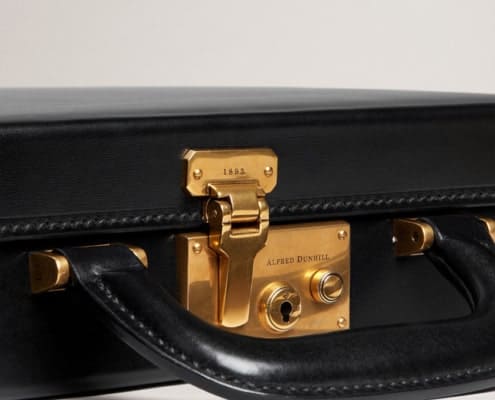
Another thing most of these bags had in common was a closing mechanism or clasp. Initially, they used keys to lock them, and later, combination locks. But, pretty much any type of box-like or Gladstone bag had something that you could lock them with.
In this day and age, it’s possible that you may not even use keys anymore, so keeping track of a tiny one for your bag is probably not very practical and that’s the reason most modern attaché cases have a combination lock.
Vintage leather cases from Bentleys Antiques
Attaché Case vs. Briefcase
The key difference here is that the attaché case is stiff and rigid with corners and a briefcase is just soft, and then, there’s, of course, the name.
The “attaché case” is derived from a position in diplomacy from the French “attaché.” Basically, you had the ambassador, minister, minister-counselor, counselor, first secretary, second secretary, third secretary, and then, the glorious attaché with the attaché assistant beneath him.

Because of the accent and the ‘é’, you pronounce the ‘e’ and it’s an “attaché case,” not an “attach case.” The box-like leather case used by attachés became synonymous and so, it got its name: attaché case.
Back then, the primary function of the briefcase was the transportation of documents. So, likely, there were some ink wells in there, some forms of pens, and, of course, lots of paper. In short, it was a portable desk that included stationary.
What’s the difference between an attaché case and a briefcase, then? Well, overall, “briefcase” is a wider term that encapsulates any bag or box that contains briefs. So, an attaché case is a briefcase, but not every briefcase is an attaché case. And with briefs, we mean paper documents, not underwear.

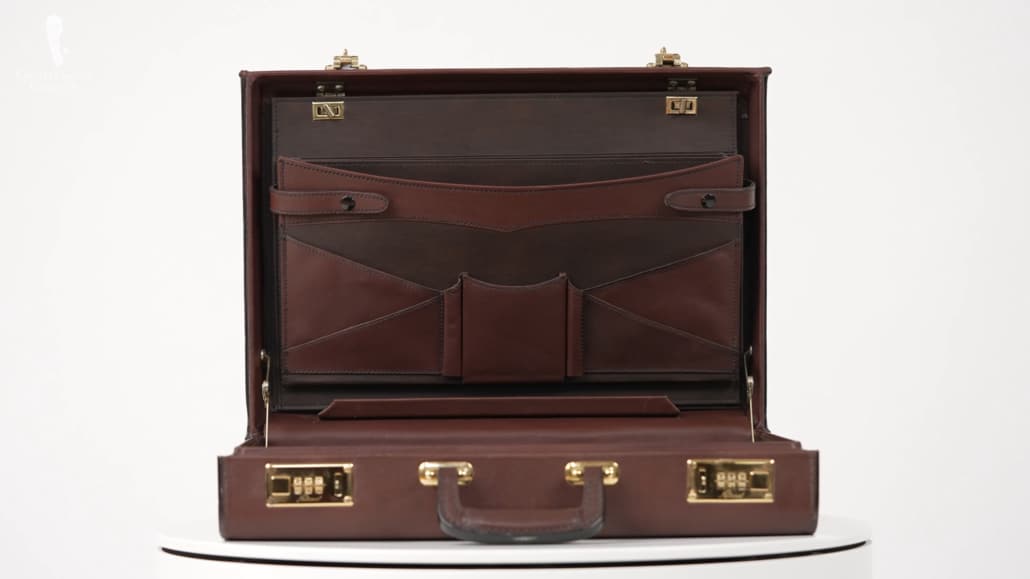
So, if today, someone refers to a “briefcase,” chances are they refer to a satchel-style briefcase or maybe a folio-style briefcase or a gusset-style briefcase with a flap over top that has a lock?
Hallmarks of an Attaché Case
First, you have the handle, then you have the hinge on the opposite side. You have the box-like steel or wooden frame construction, typically made out of a stiff leather. So, it’s a rigid container. Often, you have a lining, but it’s not necessary, technically. But, then, you may have a document pouch on the inside, which can be a divider. It can be pen holders or whatever it is that you want.
Sometimes, you also have a divider that is more like a desk surface that is rigid, which allows you to send something with a case open. So, you don’t have to close it in between.
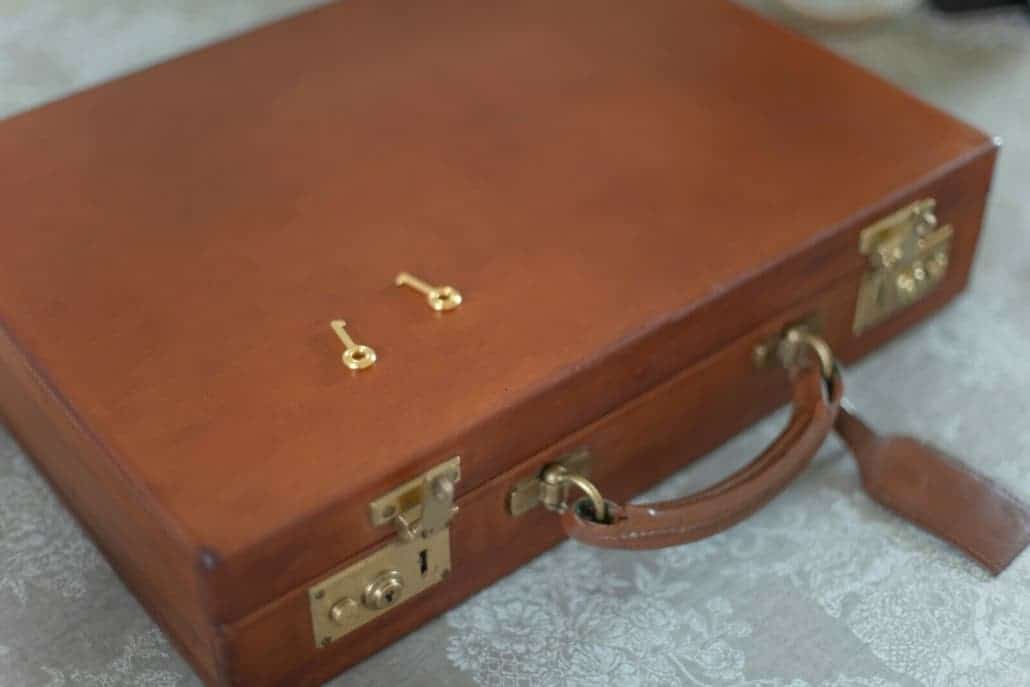

You also typically have the aforementioned locks, whether combination or key locks. And then, last but not least, a good attaché case will have some feet out of metal – it’s typically brass – so the leather doesn’t wear as easily when you put it down on the ground.
Sometimes, you may even see reinforced leather corners or metal-enforced corners, but this is not a requirement on an attaché case.
Ultimately, the attaché case is a simple box designed to hold an A3 sheet of paper, which is about 42 by 29 centimeters or around 16 and a half by 12 inches, which is why most cases that are attaché cases are about 18 by 12 by 3 or 4 inches. So, you comfortably fit that format of paper in them.
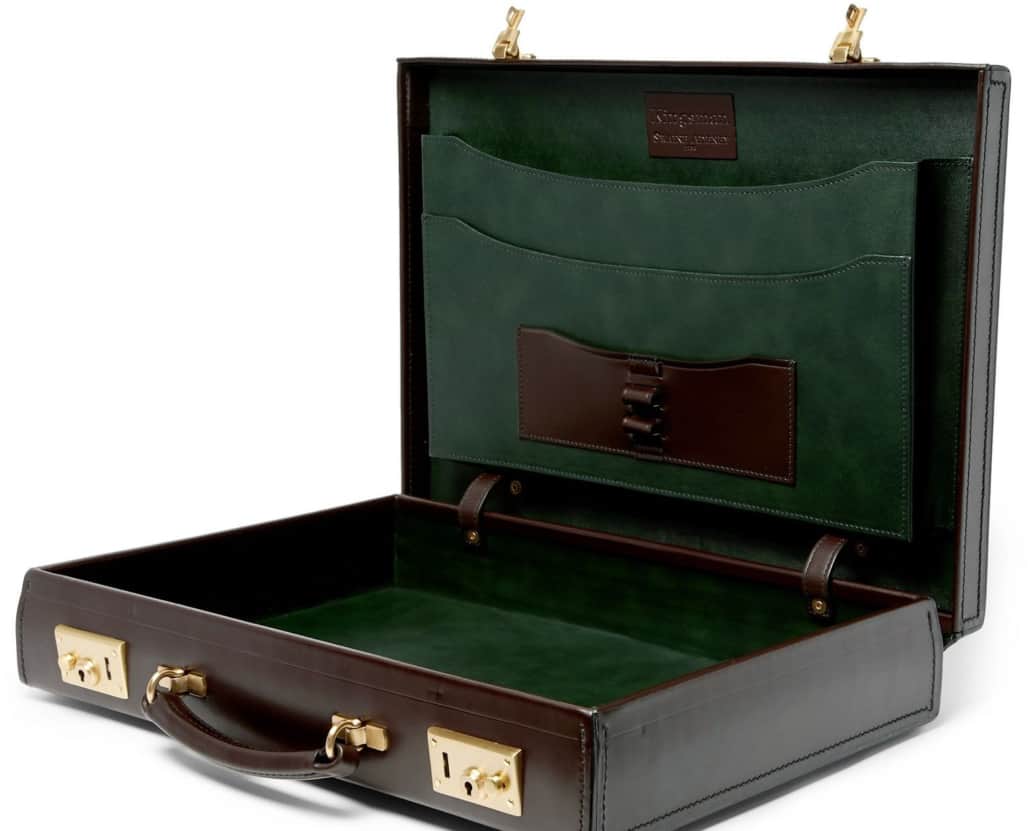
Compared to a suitcase or other bags, it seems rather small, but that’s the point because you don’t want something big, that’s not agile, and that you’re able to carry around.
Of course, in this day and age, you’ll find different attaché cases. Sometimes, they’re quite wide. They’re also called “pilot cases” and they could function like small suitcases, or you can find very slim ones. But, most attached cases are in the dimension range mentioned.

If you need something larger for everyday use, you should probably rethink your everyday carry.
Attaché Case vs. Other Bags: Which is Best?
So, with all the other options out there, ranging from backpacks to satchel-style folios, over duffel bags, and so forth, why would you still wear an attaché case? Well, let’s compare it one by one to other bags.

Backpack
Probably the most widely used bag today is the backpack. It is very utilitarian and it makes you look like a schoolboy when you wear it. So, it really sacrifices your stylishness in all its glory. Plus, when you carry it on your back, it’s very easy to bump other people when you turn around without even noticing it, especially when you’re in a tight space like a metro or train or a bus.
An attaché case, on the other hand, is a lot more elegant. It doesn’t have any shoulder straps and it’s better suited for your jacket shoulder because the strap really ruins it if you wear it over long periods of time.
Satchels and Messenger Bags
What about satchels or messenger bags? They typically have a handle, but they can be rather flimsy. They also come with a shoulder strap, which can be nice because then you can switch between your handles and your shoulder. But, again, it will ruin your suit or jacket’s shoulder.
A satchel, typically, can be opened while you carry it. You don’t have to put it down, so it’s easier to access it. But, you also don’t see everything at once unlike with an attaché case.

Also, typically, attaché cases have a much sturdier constructed handle with lots of leather, sometimes, also some foam padding. So, actually carrying it by hand is a lot more comfortable than most satchels, which are typically just leather and that can be quite harsh if you carry it for longer periods of time.
Tote Bags
I will give it to you. Tote bags have become much more popular and you can even see men wearing them just to go about town. You can carry it in your hands or just throw it over your shoulder and just throw everything inside.
Well, the problem is — let’s say, you have a laptop in there and maybe it’s winter and you slip, stuff can fall out. With an attaché case, that’s not the case.

Duffle Bag
Finally, there’s the duffle bag or the weekender, which is meant to be like an overnight bag or a weekend bag. It’s much bigger, and it’s really not as versatile as an attaché case. Also, let’s say, you put your laptop in there, nothing else, there’s just way too much space in there, so it’s meant for travel and the attaché case is better for the city.
Some may argue, the attaché case is also more secure. I would say that anyone can just pry it open. At the end of the day, whether you wear an attache case or a satchel-style briefcase is entirely up to you. Both are legitimate. Personally, I think, with an attaché case and a full suit on, it just looks a lot more handsome and elegant.

Using Your Attaché Case
So, if you have one or if you decide you want to give it a try, how can you make the most out of it?
First of all, take everything out of your jacket pockets, your pants’ pockets, and put it in your attaché case. Just carry with you day in, day out. Everything on your body will feel lighter, the silhouette will look better, and everything will be stored in your attaché case.


It also fits your laptops, your tablet, maybe some documents, and you could even have little snacks in there. I mean, who doesn’t like mini salamis or maybe chocolate? Maybe, you want to have a liquor flask in there, too.
You can also use it like James Bond and make a little mini suitcase out of it. I mean, shirt, tie, and shoes – no problem in an attaché case.
Buying an Attaché Case
Some argue that probably the best cases come from England. And while I agree that there are great attaché cases that are made in England, you can also find great other ones from places like Germany, Japan, France, Italy, and so forth. We talk about whether “made in” really matters in a separate post.
The Bond attaché case I just mentioned from the 1963 movie “From Russia With Love” was actually made by Swaine Adeney Brigg, a traditional English maker of attaché cases, and they still offer that same style today. It’s black with a red lining, no interior inserts, and very puristic.


Swaine Adeney Brigg has been in administration, I think, since 2012. It’s now under new ownership. They used to have a much larger store. They offered more things. They also private label cases. Today, they have a small store in the Piccadilly Arcade in London and still seem to be making high-end, costly attaché cases.
In the original 007 movie, the attaché case came with a whole slew of tools, such as extra bullets, throwing knives, and tear gas canisters, which, of course, are not sold by Swaine Adeney Brigg. And in a scene on the Orient Express, we can see how Bond uses it as an overnight case with a tie and some pajamas in there.

Cost Per Wear
Attaché cases can come with lots of different details, such as metal hinges on the side or maybe certain sub-dividers, certain really nice expensive leather linings, or other things. But, it’s not ultimately necessary. What matters is your cost per wear and so, the upfront investment may be high, but, over the course of time, it will be lower if you can use your case a lot.
That being said, attaché cases used to be really popular and, these days, they’re not so popular anymore. Because of that, you can find lots of high-quality attaché cases at very low prices on a used market.


Sometimes, you see attached cases from famous brands like Esprit or Dunhill going for $30 or $50, but the problem is the shape and the condition they’re in. In order to get it properly working and functional, you’d have to invest hundreds of dollars to have them repaired. So, instead, it may be better to spend maybe $100 or $200 on a case that is in like-new or mint condition.
Case Condition & Maintenance
First of all, you want to look at any metal hinges. Is there corrosion, and do they open evenly and smoothly? If the attaché case is hinged with leather, make sure it’s still strong and not weak and cracking. Yes, leather on a hinge will always crease. That’s normal. But, if the leather is overly dry, it is not very solid anymore and can rip much more easily.

Therefore, you also want to look for any type of fraying on the leather or maybe deep scratches because they can just be removed with a magic eraser.
Also, if there’s a handle that’s starting to fray or if you see any stitches coming undone, you probably want to pass on that case because a high-end brand typically has the case hand sewn, not machine sewn, which is quite costly. So, if you’re looking for a used case because you’re on a budget, buying one that is overly worn or used is actually rather expensive.
If you’re, for example, on eBay and you look through old attaché cases, you could see lots of stains – people left their inkwell in there and, of course, it broke – or they had any other type of fluid in there and, once it leaks out, you won’t notice right away. But, then, if it doesn’t dry evenly, you have water stains and it’s a pain to remove those.

So, if you do have a really nice-looking one, maybe don’t put the inkwell in there and be careful with your beverages. If the leather gets dirty, you can mostly use saddle soap on the leather, which helps in getting it out.
You can also nourish it with shoe polish. There are various renovator products – cream shoe polish, water-based ones, waxed ones. Oftentimes, they’re colored, too. So, if an edge is slightly rough and the edge paint has come off, you can reapply it. It makes your case look almost like new again if the bones of the case are in good shape.
You never want to buy an attaché case that is dented because that means you have to redo the frame and that’s a lot of handwork. Also, remember, any type of leather good that you use is meant to be worn and you develop a patina, meaning there are scratches, there are some discolorations, but with shoe polish, you can take care of that.

After all, a well-loved and well-worn piece of leather is, to many, more desirable than a brand new bag.
Frankly, attaché cases are not high maintenance at all. If you just take care of them once or maybe twice a year, that’s all it needs.
Quality Case Materials
In terms of the locking mechanisms, there’s big differences out there. I, personally, like solid brass locks, not the kind of cheap zamac locks, and you can typically tell the thicker, heavier locks are better quality, are meant to last, whereas the cheaper stuff will just oxidize in a weird way.

In terms of leather, you can find bright leather, which is a very thick, saddle leather. Sometimes, also, people use belting leather, which is not the leather used for regular menswear belts, but more like industrial thick belts that are in an engine, that have to keep working. You probably never want lambskin leather, even though it’s really soft. It’s thinner and not as durable.
On the other hand, if you would choose peccary, which is an excellent glove leather, it would probably be too soft. Even though it’s very durable, the skin is just too small to cover an attaché case. You’d have to connect the skins and then, you have seams. It’s much nicer if it’s one continuous surface from a calfskin or a cowhide.

Attaché Case Colors
In terms of color, most attaché cases are available in shades of brown, black, or burgundy. Every once in a while, you’ll find gray ones, maybe navy ones, blue ones, even solid red ones. Those are much harder to come by. You probably have to make them custom. But, there are still many makers who can offer that for you. Just be prepared to pay a lot of money for those.
How much exactly? Well, you know, Swaine Adeney Brigg will probably charge you around $5,000 for a custom attaché case in a leather of your choice.
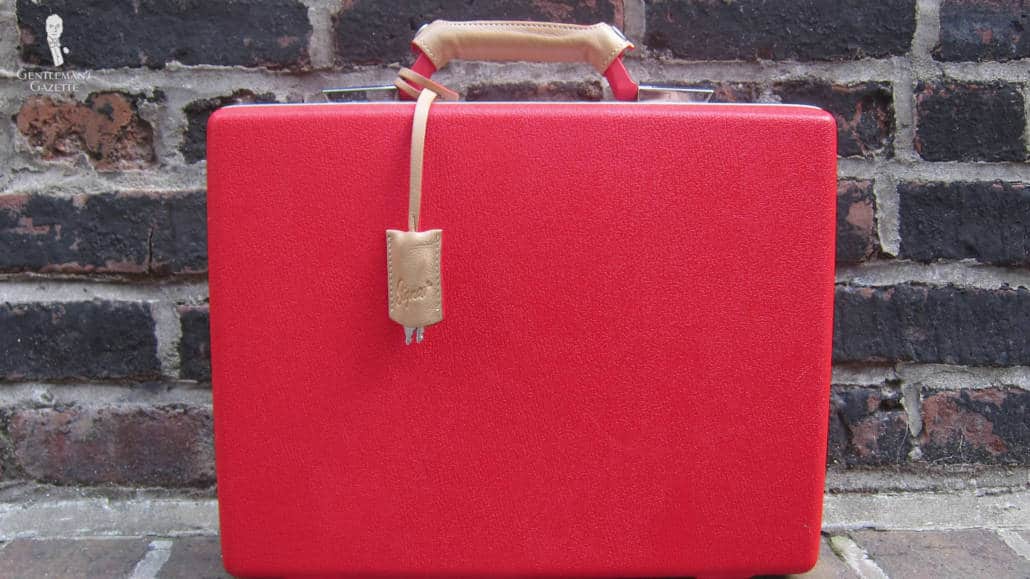
Ultimately, my tip would be: choose a color of the attaché case that matches the shoes you’ll wear with it. So, if you wear a lot of three-piece suits with black shoes, get a black attaché case. If you like to wear it with brown shoes, well, get a brown case. You can probably find inexpensive ones, and you can buy a black one and a brown one together for $400 or $500.
Attaché Case Brands
In terms of what brands to buy new, I’d say there are still manufacturers out there such as Swaine Adeney Brigg, Globetrotter, or Halliburton. But, a lot of brands that used to make them no longer offer them.
Seeger was really high-quality. They’re no longer in business, but if you can find a Seeger attaché case, it’s really well-made.
Of course, there’s also Hermes, which is supremely expensive, but their stuff is always well-made. Otherwise, a brand called Goldpfeil used to make really nice attaché cases, so did Korchmar and Schlesinger.

Korchmar is still around, I think. They now produce mostly offshore, not much in the US anymore. And probably their offerings of other attaché cases is limited, but, again, vintage, you may find something.
Also, brands like Ghurka or small craftsmen like Marcellino from New York offer great stuff and, if you find something, go for it. Otherwise, Mulholland Brothers, Filson, or Mark Cross may be interesting. Maybe J W Hulme or the Duluth Trading Company may have something. Of course, there’s also other British brands like Papworth, Tanner Krolle, Asprey, Pickett, and so forth.
Sometimes, you also find that high-end makers made stuff for Bentley or Rolls-Royce, so that can be a high-quality attaché case at a low price. We even find stuff like from Foster & Son or from Davidoff.

Honestly, even vintage Gucci from the 80s, 70s, and 60s had really nice attaché cases with nice little details like soft pouches on the outside or extra locks.
Of course, Brooks Brothers and their sub-brand Peal & Co. also had them. Ralph Lauren had them. Maybe J. Peterman or Burberry still had them. And, frankly, there’s a bunch of other companies like Serapian from Milano.
To round up, here’s a full list of great quality attaché case brands:
Montblanc
Seeger
Hermès
Braun Büffel
Goldpfeil
Korchmar
Schlesinger
Ghurka
Marcellino NY
Mulholland bros
Mark Cross
Filson
Orvis
J.W Hulme (The US made stuff, not from China)
Duluth Trading Company
Jack Georges (Made in USA)
King Ranch
Patrick Sance
Tallgrass Studio
Lewis Drake
Swaine Adeney Brigg
Papworth
Pendragon
Tanner Krolle
Asprey
Boyt
Rolls Royce (Made for them by high-end English brands)
Bentley (Made for them by high-end English brands)
Foster & Son
Pickett of London
Dunhill
Zino Davidoff
Gucci Vintage
Tumi Vintage
Ralph Lauren
J. Peterman
Brooks Brothers
Burberry
Peal & Co. (often made in England by Swaine Adeney Brigg)
Groundcover
Lefren
Serapian – now Richemont owned, had cool designs
What Attaché Cases Do We Have?
I have a nice one from the brand Schlesinger made for Brooks Brothers. They were found in 1919, but are no longer around. I like the shape of this one. It was a vintage one and got it for under $200.
I have a Swaine Adeney Brigg. It was a little in tougher shape and had to kind of clean up a little bit. But, now it looks really nice.
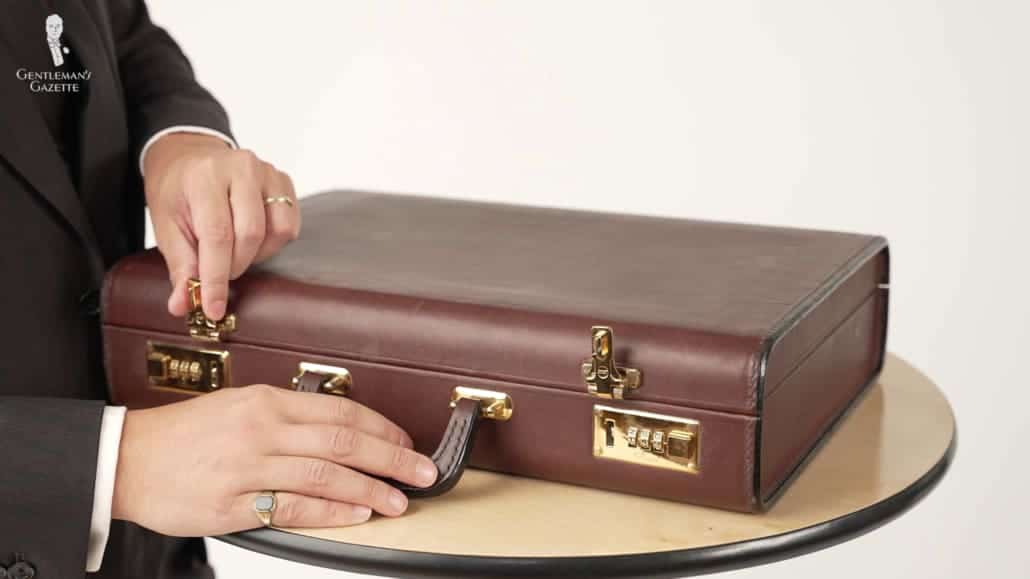
Jack has one from Papworth. Very similar. I think Papworth is now owned by Swaine Adeney Brigg, but it’s more machine-made versus the others that are still hand-sewn.
Conclusion
As I said, you set your budget, search for it, and, if you come across something, just get it. You probably won’t regret it. At least, we didn’t!
Outfit Rundown
Today, I’m wearing the Schlesinger attaché case in brown with gold combination locks. My suit is a three-piece suit with a brownish-gray and like orange-reddish stripes. I’m combining it with an off-white, double-cuffed shirt with a somewhat spread collar. A tie from Fort Belvedere that is wool challis, printed in burgundy with a yellow polka dot. My pocket square is a wool-silk blend also from Fort Belvedere in green tones, orange, and red that pick up the color of the tie, but still provide a little bit of contrast.
My socks are burgundy and off-white shadow-stripe socks from Fort Belvedere. For my shoes, I chose a pair of Oxfords in a color that matched my attaché case and with a faux cap toe. So, it looks like a cap toe, but it actually isn’t. It also is a pointed one, which is not something you typically find on a ready-to-wear shoe because it’s really difficult to get that tip aligned with the center of your shoe in a factory.
For my cufflinks, I chose a pair of gold monkey fist knot links from Fort Belvedere, which you can find in our shop, just like all the other accessories. And, on my pinky finger, I have a little ring with a bloodstone with green and red that pick up the colors of the pocket square, the tie, and the suit. I chose gold for my accessories because my attaché case also had gold locks.
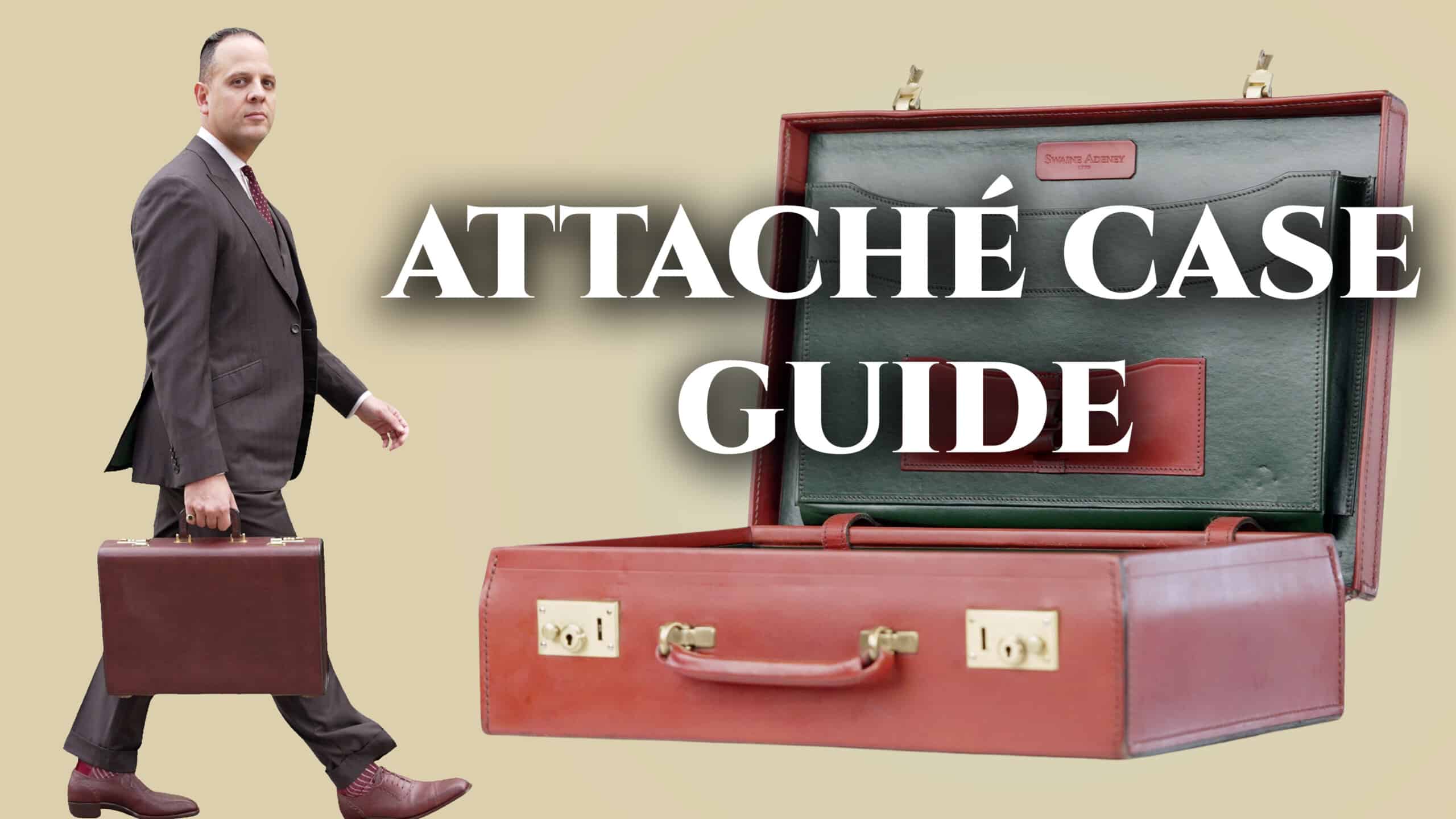






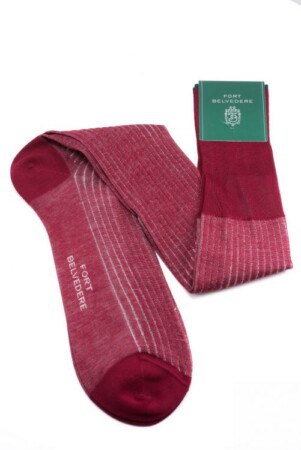
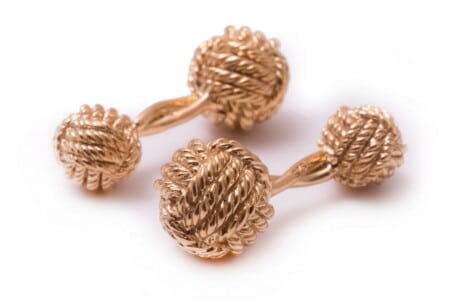
I loved my Halliburton Zero until the latches broke and it couldn’t be fixed. Then I switched to a Booq computer bag with lots of pockets, lightweight too. Booq no longer exists, but 10 years later the bag and all zippers work fine.
I plan to buy both a black and a brown attache’ case to match my black and brown shoes, but is it necessary for me to buy them with both gold and silver metal to match my gold and silver jewelry? That would mean I’d have to buy 4 attache’ cases to cover all my bases (1. black w/silver metal, 2. black w/gold metal 3. brown w/silver metal, 4. brown w/gold metal). This seems like overkill to me, so I’d like to know what the style rules are regarding this – thanks.